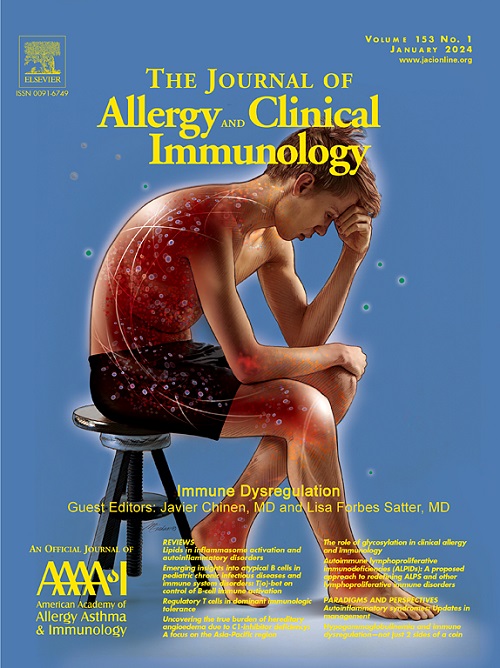Mast cells activated in vitro can modulate macrophage polarization and antibacterial responses
IF 11.2
1区 医学
Q1 ALLERGY
引用次数: 0
Abstract
Background
Mast cells and macrophages are tissue-resident immune cells frequently found in close proximity in barrier organs. Macrophages show high plasticity and microenvironmental factors, such as cytokines, can influence their phenotype. Mast cells are central in allergic reactions where allergens cause mast cell activation via antigen-specific IgE antibodies and the release of a multitude of inflammatory substances. While macrophages have clearly defined physiologic roles in tissue maintenance and host defense against microbes, biological mast cell functions are less well defined.
Objective
In the current study, we aimed to understand the interplay of mast cells and macrophages and how mast cell–released mediators can shape macrophage phenotype and function.
Methods
Using primary in vitro models of mast cells and macrophages combined with microscopic, functional, metabolic, genetic, and epigenetic analyses, we investigate the macrophage polarization effects of mast cell mediators produced on activation with IgE and antigen. We apply a macrophage engraftment strategy to explore potential in vivo implications of mast cell–mediated priming.
Results
We find that preformed and newly synthesized mediators released by activated mast cells shape a macrophage phenotype different from the classical M1/M2 macrophage paradigm. Exposure to supernatant of activated mast cells induces epigenetic reprogramming of macrophages. This profound priming effect strongly alters macrophage phagocytosis, cytokine production, and transcriptomic responses on secondary exposure to bacteria or their products. Importantly, in vivo transfer of primed macrophages also significantly affects the outcome of sterile inflammation and bacterial peritonitis.
Conclusion
Our study highlights the great potential of activated mast cells as directors of macrophage function.

体外活化的肥大细胞可调节巨噬细胞极化和抗菌反应。
背景:肥大细胞和巨噬细胞是经常在屏障器官中发现的组织驻留免疫细胞。巨噬细胞具有较高的可塑性,细胞因子等微环境因素可影响其表型。肥大细胞是过敏反应的中心,在过敏反应中,过敏原通过抗原特异性IgE抗体引起肥大细胞活化,并释放大量炎症物质。虽然巨噬细胞在组织维持和宿主防御微生物方面的生理作用被明确定义,但肥大细胞的生物学功能却不太明确。目的:在本研究中,我们旨在了解肥大细胞和巨噬细胞的相互作用,以及肥大细胞释放的介质如何影响巨噬细胞的表型和功能。方法:利用肥大细胞和巨噬细胞体外原代模型,结合显微镜、功能、代谢、遗传学和表观遗传学分析,研究IgE和抗原激活肥大细胞后产生的肥大细胞介质对巨噬细胞极化的影响。我们应用巨噬细胞植入策略来探索肥大细胞介导的启动在体内的潜在影响。结果:我们发现激活肥大细胞释放的预形成和新合成的介质形成了一种不同于经典M1/M2巨噬细胞模式的巨噬细胞表型。暴露于活化肥大细胞的上清液可诱导巨噬细胞的表观遗传重编程。这种深刻的启动效应强烈地改变了巨噬细胞吞噬、细胞因子产生和二次暴露于细菌或其产物时的转录组反应。重要的是,巨噬细胞的体内转移也显著影响无菌炎症和细菌性腹膜炎的预后。结论:我们的研究强调了活化肥大细胞作为巨噬细胞功能指导的巨大潜力。
本文章由计算机程序翻译,如有差异,请以英文原文为准。
求助全文
约1分钟内获得全文
求助全文
来源期刊
CiteScore
25.90
自引率
7.70%
发文量
1302
审稿时长
38 days
期刊介绍:
The Journal of Allergy and Clinical Immunology is a prestigious publication that features groundbreaking research in the fields of Allergy, Asthma, and Immunology. This influential journal publishes high-impact research papers that explore various topics, including asthma, food allergy, allergic rhinitis, atopic dermatitis, primary immune deficiencies, occupational and environmental allergy, and other allergic and immunologic diseases. The articles not only report on clinical trials and mechanistic studies but also provide insights into novel therapies, underlying mechanisms, and important discoveries that contribute to our understanding of these diseases. By sharing this valuable information, the journal aims to enhance the diagnosis and management of patients in the future.

 求助内容:
求助内容: 应助结果提醒方式:
应助结果提醒方式:


